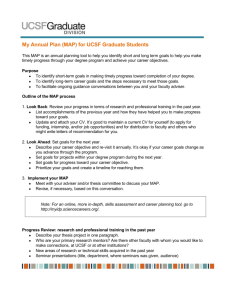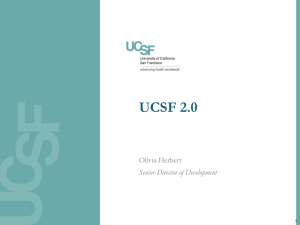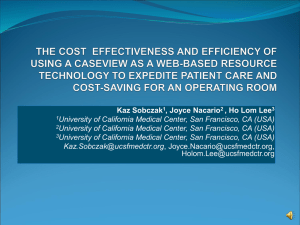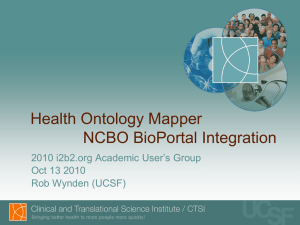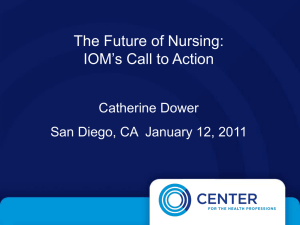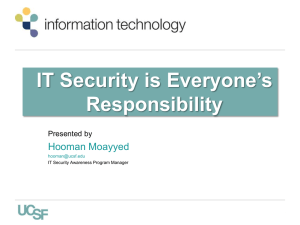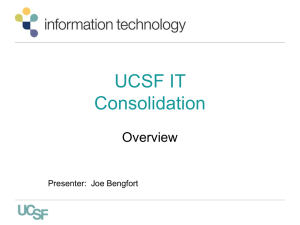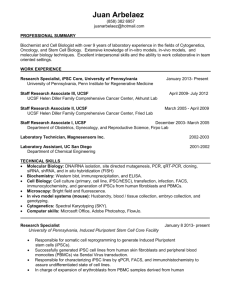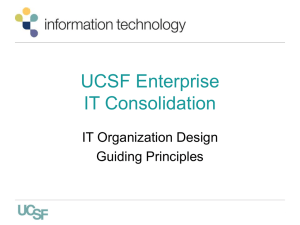Lab Safety Orientation:
advertisement
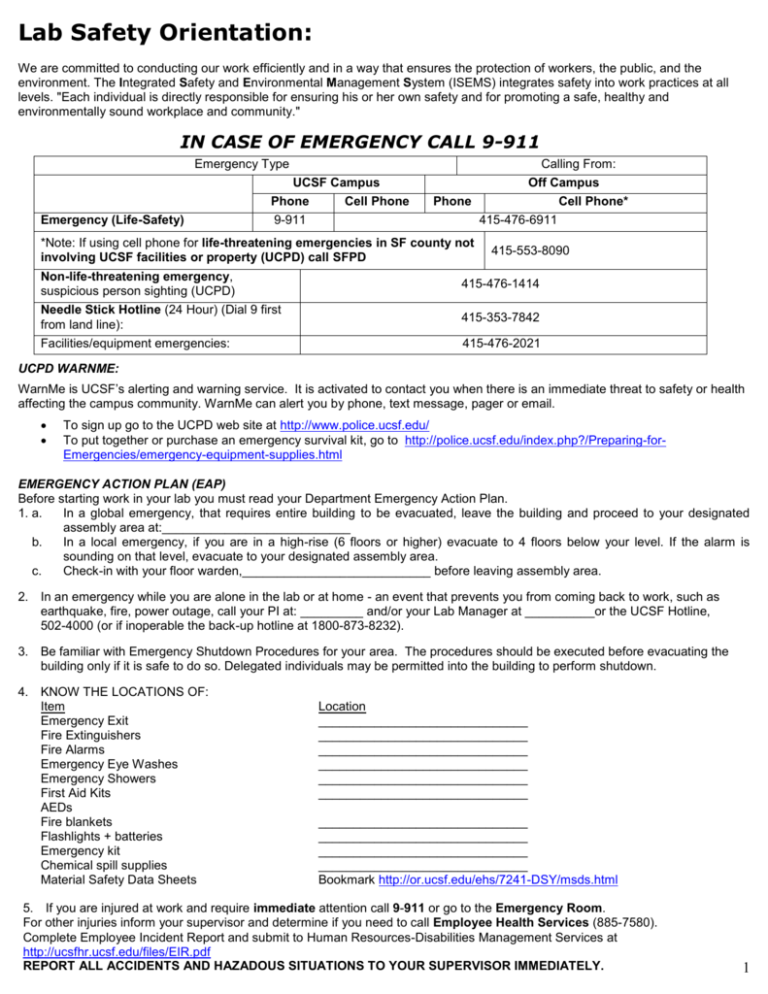
Lab Safety Orientation: We are committed to conducting our work efficiently and in a way that ensures the protection of workers, the public, and the environment. The Integrated Safety and Environmental Management System (ISEMS) integrates safety into work practices at all levels. "Each individual is directly responsible for ensuring his or her own safety and for promoting a safe, healthy and environmentally sound workplace and community." IN CASE OF EMERGENCY CALL 9-911 Emergency Type Calling From: Off Campus UCSF Campus Phone Emergency (Life-Safety) Cell Phone Phone 9-911 415-476-6911 *Note: If using cell phone for life-threatening emergencies in SF county not involving UCSF facilities or property (UCPD) call SFPD Non-life-threatening emergency, suspicious person sighting (UCPD) Needle Stick Hotline (24 Hour) (Dial 9 first from land line): Facilities/equipment emergencies: Cell Phone* 415-553-8090 415-476-1414 415-353-7842 415-476-2021 UCPD WARNME: WarnMe is UCSF’s alerting and warning service. It is activated to contact you when there is an immediate threat to safety or health affecting the campus community. WarnMe can alert you by phone, text message, pager or email. To sign up go to the UCPD web site at http://www.police.ucsf.edu/ To put together or purchase an emergency survival kit, go to http://police.ucsf.edu/index.php?/Preparing-forEmergencies/emergency-equipment-supplies.html EMERGENCY ACTION PLAN (EAP) Before starting work in your lab you must read your Department Emergency Action Plan. 1. a. In a global emergency, that requires entire building to be evacuated, leave the building and proceed to your designated assembly area at:___________________________ b. In a local emergency, if you are in a high-rise (6 floors or higher) evacuate to 4 floors below your level. If the alarm is sounding on that level, evacuate to your designated assembly area. c. Check-in with your floor warden,___________________________ before leaving assembly area. 2. In an emergency while you are alone in the lab or at home - an event that prevents you from coming back to work, such as earthquake, fire, power outage, call your PI at: _________ and/or your Lab Manager at __________or the UCSF Hotline, 502-4000 (or if inoperable the back-up hotline at 1800-873-8232). 3. Be familiar with Emergency Shutdown Procedures for your area. The procedures should be executed before evacuating the building only if it is safe to do so. Delegated individuals may be permitted into the building to perform shutdown. 4. KNOW THE LOCATIONS OF: Item Emergency Exit Fire Extinguishers Fire Alarms Emergency Eye Washes Emergency Showers First Aid Kits AEDs Fire blankets Flashlights + batteries Emergency kit Chemical spill supplies Material Safety Data Sheets Location ______________________________ ______________________________ ______________________________ ______________________________ ______________________________ ______________________________ ______________________________ ______________________________ ______________________________ ______________________________ Bookmark http://or.ucsf.edu/ehs/7241-DSY/msds.html 5. If you are injured at work and require immediate attention call 9-911 or go to the Emergency Room. For other injuries inform your supervisor and determine if you need to call Employee Health Services (885-7580). Complete Employee Incident Report and submit to Human Resources-Disabilities Management Services at http://ucsfhr.ucsf.edu/files/EIR.pdf REPORT ALL ACCIDENTS AND HAZADOUS SITUATIONS TO YOUR SUPERVISOR IMMEDIATELY. 1 Researcher Orientation Checklist Name:_________________________________________ Lab PI:_________________________________ University Orientation: (contact your Department Administration) 1. Obtain a university proxy ID badge and have it activated. 2. Obtain a lab coat and get an email account. 3. Complete mandatory HIPAA training. http://www.research.ucsf.edu/CHR/HIPAA/HIPAAtrng/hipaa1.HTM 4. File Contact information with: 5. Sign out key(s)/codes(s) and activate proxy card. Location ___________________________________ Date _______________ _______________ _______________ _______________ _______________ Basic Safety Training: 1. Check with your supervisor to determine which training you need and use your Employee ID to log in to UC Learning Center https://learningcenter.ucsfmedicalcenter.org/default.aspx 2. How to access training online tutorial http://or.ucsf.edu/ehs/7240-DSY/14655 3. Visiting scholars without a UCSF ID Number can take online UCSF "eCourses” by sending an email with your name to Training@ucsf.edu. You will be emailed a unique Sign-in ID and password that will provide you with temporary (2 weeks) access to the learning management system. Class Date Class Date Lab Safety for Researchers Laser Safety Awareness Biosafety Controlled Substances Bloodborne Pathogen Fire Safety Safe Shipper (Infectious Substance) Machine Guarding Herpes B Q-Fever Prevention Human Carcinogens Formaldehyde Training Liquid Nitrogen Safety Safe Handling and Use of Pyrophoric Chemicals Radiation Safety Office Ergonomics Lab Ergonomics Lab Safety for Assistants Animal Welfare training, PAGE 4 Human Subjects Protection, PAGE 5 4. Check, if your work involves animal use refer to Animal Welfare web site for details. 5. Complete lab-specific training provided by your PI and/or lab supervisor. 6. Before performing any work, ask the PI or lab supervisor to add you to appropriate Use Authorizations (radioactive, biological & controlled substances). For controlled substances, submit Information on Authorized User of Controlled Substances form. Communicable Disease Prevention Program is managed by UCSF Occupational Health Program (OHP): http://www.occupationalhealthprogram.ucsf.edu/Forms/Hepatitis_B_Consent_Declination_Form.pdf visiting scholars without a SSN # can enter 0000 to login UCSF Policy Regulations: 1. Obtain Material Transfer Agreements (MTA) to send proprietary reagents 2. Know how to keep proper lab notebooks by consulting this link http://www.otm.ucsf.edu/docs/otmLabProc.asp 3. Be aware of University whistleblower policy: http://whistleblower.ucsf.edu/ 4. Complete UC Ethical Values and Conduct found in UC Learning Center Overall Safety Check: 1. Emergency Action Plan I have read and understand the EAP 2. Emergency Phone numbers I know where these are posted 3. Basic Lab Safety Rules I have read and understand attached rules 4. Emergency Evacuation Route: my Dept/ neighborhood emergency assembly site ____________ Signature _________________________________ Date _________________ Keep copies of all training records and your Research Information Online (RIO) login and password. 2 Basic Lab Safety Rules: All jobs are performed within the guidelines of the Illness and Injury Prevention Program (IIPP); Review http://or.ucsf.edu/ehs/8083-DSY/version/default/part/4/data/ before beginning work; tasks should be identified, the associated hazards evaluated, and a set of safety standards and requirements established. This is most easily done by performing a "dry run" in advance. 1. Be familiar with the hazards, handling procedures and disposal methods for all the chemicals you will be using in an experiment. Review Material Safety Data Sheet (MSDS) online and/or check with your EH&S Specialist http://or.ucsf.edu/ehs/about.ehs/8512-DSY.html 2. Determine appropriate personal protective equipment (PPE) and training needed based on lab hazard assessment. 3. When working with hazardous materials, it is your responsibility to be familiar with and use appropriate PPE (knee-length lab coat, gloves, closed-toed shoes, protective eyewear, etc.) PPE are always required when working in BSL2/BSL3 labs, when handling radioactive materials and/or when working with hazardous chemicals. 4. Do not walk through office areas, conference, and eating rooms with lab coats or lab materials. 5. Lab Gloves should not come into contact with door handles, elevator buttons, or phones, etc. 6. Food or drink storage is allowed only in designated refrigerators. No eating or drinking is allowed in labs. No food or drink waste should be disposed of in lab trash cans. 7. If you handle human tissue or blood, prepare yourself by adhering to the guidelines in, “Preparation for Working with Human Patients or Tissues.” See page 6. 8. Liquid Nitrogen can cause severe burns. When handling it, use appropriate PPE: clothing, eyewear and gloves. 9. Phenol can cause severe burns. When handling it, work in fume hood with appropriate PPE: lab coats, goggles and gloves. Take extra precautions when working with Phenol & chloroform mixtures, as chloroform can dissolve gloves, exposing skin to phenol burns. Read Safety Updates: Chloroform-Safe Gloves and Emergency Procedure for Phenol/Chloroform. Waste Disposal guidelines: 1. Needles, syringes, glass Pasteur pipettes, razor blades and scalpels must be disposed whole in sharps container to be collected by EH&S. 2. Uncontaminated broken glass or other sharp objects should not be placed in normal trash containers. Place in appropriate box (i.e. sturdy cardboard, lined with plastic). 3. All Biohazard or Medical Waste must be put in a RED bag placed within a hard-sided biohazard container with a tight-fitting lid. The bags must be sealed. See your lab supervisor for the correct procedure. 4. Dispose Chemical Waste using the Online Tag Program (OTP) http://otp.ucsf.edu/. Waste must be properly labeled and tagged by user for pickup by EH&S, within 120 days. See your lab supervisor for the correct procedure. 5. Radioactive waste must be segregated and tagged by user for pick-up by EH&S. See your lab supervisor for the correct procedure. 3 Animal Welfare Training and Facility Access: IACUC is the Institutional Animal Care and Use Committee: http://www.iacuc.ucsf.edu LARC is the Laboratory Animal Resource Center: http://www.larc.ucsf.edu See your Lab Manager for lab specific training. Training requirements: 1. Basic Regulatory and Ethical Requirements Take the online classes BRER I (required for all users) and BRER II (required if you are performing anesthesia and/or surgery) at: https://learningcenter.ucsfmedicalcenter.org/default.aspx. 2. If you are using an isoflurane machine, take the online class IACUC Rodent Isoflurane Machine at: https://learningcenter.ucsfmedicalcenter.org/default.aspx 3. Hands-on species-specific training (required for all users of sheep and primates and users with < 12 months of experience with the species they will work with). For Rodent basic handling training sign up online at http://www.iacuc.ucsf.edu/Training/awTrain.asp. For other species or special techniques (blood collection, gavage, etc.), email TrainerIACUC@research.ucsf.edu or call 502-7408 to schedule training. 4. Complete the Medical Health Screening (MHS) Questionnaire in Research Information Online https://rio.ucsf.edu/RioLoginSelector/LoginSelector.aspx See EH&S contact information below if you have health questions or concerns about working with any species. If you will work with sheep or non-human primates, you must schedule an appointment to complete species-specific health requirements and obtain a health clearance. For any questions, you may contact Dr. Krista Lindstrom at krista.lindstrom@ucsf.edu. 5. Facility orientation: An appointment is required. Check with your supervisor or call the LARC office 476-2204 for the LARC facility Supervisor’s name and contact information for your site. If you will work in Parnassus Services Building, you must also take the IACUC Rodent Barrier Training (PSB only) and sign up for an in-person PSB Facilities Orientation at https://learningcenter.ucsfmedicalcenter.org/default.aspx 6. For your health and safety, review the information at http://www.iacuc.ucsf.edu/Safe/awSafeOhs.asp for worker protection policies, species specific concerns, a quick guide to working safely with animals, contacts and emergency procedures. Facility Access: 1. Ask your PI or lab manager to request addition of your name to the appropriate IACUC protocols. You must read, understand and sign the protocols before performing any animal work. 2. Request activation of your proximity card to give access to the appropriate LARC facilities and rooms (consult your lab manager for the correct procedure). Download the UCSF Photo ID Proximity Card Request form from the Facilities Access link on the LARC website http://www.larc.ucsf.edu Obtain the required signatures; fill in only your name, title, department, card #, campus address and species you work with. At the top, write your P.I.’s name, plus the buildings and room numbers where you need access. Bring the form to the LARC business office during business hours for activation. NOTE: All training requirements must be completed before you will be authorized to use animals. Access to the animal facilities will not be granted until IACUC authorization is given. 4 Preparation for Working with Human Patients or Tissues. Anyone in the lab working directly with human blood, human cell lines and/or patients, must understand the risk factors associated with their work and must be properly immunized. For immunization screening and documentation, you must schedule an appointment with the UCSF Occupational Health Program (OHP) http://www.occupationalhealthprogram.ucsf.edu/ and complete the appropriate forms. All of the forms indicated below will be sent to you by the OHP when you schedule an appointment. General Requirements: If you work directly with human blood, human tissues and/or human cell lines, you will need to: 1. Complete the Bloodborne Pathogen Standard Training course. Go to: UC Learning Center https://learningcenter.ucsfmedicalcenter.org/default.aspx to access this course. Bloodborne Pathogen training must be refreshed annually. 2. Contact OHP (information below) for screening or immunization and schedule an appointment if necessary. 3. Download Hepatitis B Vaccine Compliance form. Complete and submit to OHP. http://www.occupationalhealthprogram.ucsf.edu/Forms/Hepatits_B_Consent_Declination.pdf If your job requires you to have face-to-face patient contact you will also need to: 1. Fill out OHP Initial TB Screening Questionnaire (annual refresher). 2. Complete immunity screening (measles, mumps, rubella, and varicella). To Fully Determine Your Risk and Contact the OHP office: 1. Schedule an appointment: 415-885-7580 or OHP. Your appointment will be at the OHP office, 350 Parnassus, Suite 206. 2. You will be emailed the appropriate vaccination and TB screening forms. Fill them out before your appointment. 3. Bring your personal immunization records to the appointment. • After the screening process at the OHP meeting, your info will be on file with the OHP; Keep copies for your own records. • Call Dr. Krista Lindstrom at 415-514-3531 if you have any questions during this process or other health concerns related to your lab duties (i.e. allergies to latex, etc.). 4. You will be asked to provide an account/fund for the OHP visit. Date of initial visit at OHP Exposure Hotline -24Hour pager: _______________ 415-719-3898 5 Employee Contact Information Note: This information is given voluntarily. It should be filed with a lab manager but it is confidential. The lab manager will keep it secure and will not distribute it. Name: _______________________ File Date: ________________ Lab PI: ________________________________________________ Lab Department: ______________________________________ Location of Lab bench/Office: ______________________________ Employee at Work: Email: ___________________________________________ Phone: ___________________________________________ Cell Phone: ________________________________________ Pager: ___________________________________________ Employee at Home: Phone(s): _________________________________________ Home Address: _____________________________________ ____________________________________ Emergency Contact: ______________________________________ Relationship of Contact to Employee: ________________________ To reach Contact Person at Work: Email: ___________________________________________ Phone: ___________________________________________ Cell Phone: ________________________________________ Pager: ___________________________________________ To reach Contact Person at Home: Phone(s): _________________________________________ Home Address: _____________________________________ ____________________________________ 6
